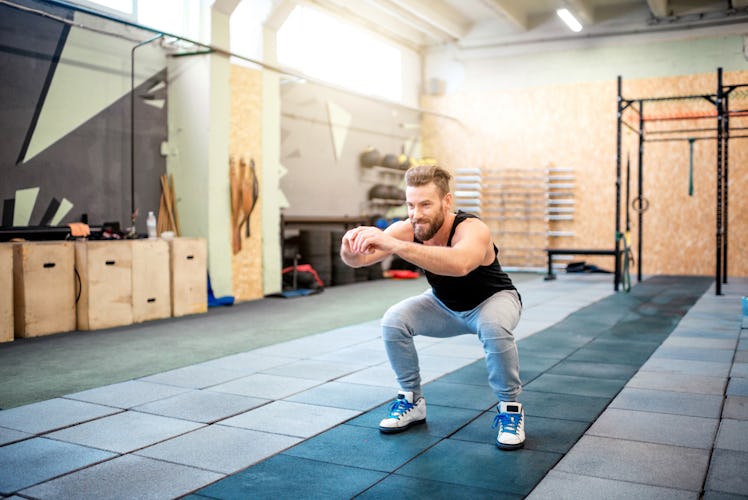The Ultimate Guide To Proper Squat Form
The centerpiece of nearly every strength-training plan, this move is easy to do — but harder to do right.

Squats. They’re up there with stretching exercises and weekend cardio. They’re so…basic. Most men know how to do squats: stand, crouch, stand, crouch. Not exactly a challenge. But learning proper squat form is essential to getting the most benefit from the exercise while preventing injury. And the numerous benefits of squats for men make it worth knowing how to do well.
When done right, a squat happens in one seamless motion: bend-drop-rise. More often than not, though, the squat presents at least one awkward moment: a jerky knee bend, uncomfortable back arch, and pause with your butt hanging way the heck out while your shoulders hunch forward for counterbalance. Finding that sweet spot of easy gliding takes practice. With a few pointers, though, you’ll be maneuvering your way through this exercise like a pro.
At the gym, you can do this move with a barbell or dumbbells. But even using your bodyweight for resistance will yield tangible results. Here are some pointers:
Proper Squat Form: A Step-By-Step Guide
- Start with your feet hip-width apart, hands by your sides, feet slightly turned out.
- Focus on holding your back straight, neither rounded nor arched. Keep your head facing front and raised slightly as you squat (pick a spot on the wall to focus on).
- To begin the squat, let your hips drift back as your knees start to bend. To counteract your center of gravity shifting behind you, allow your arms to swing forward.
- Bend deeply, imagining you are about to sit on a low stool. In fact, you can place a low seat or block beneath you, aiming to feel your butt touch it before you straighten back up. Stop your squat when your quads are parallel to the floor, to avoid injury.
- Check your posture. While some degree of lean is inevitable during a squat, the goal is to keep your spine straight, regardless of its angle, and to minimize the natural forward pitch that occurs. By keeping your weight distributed farther back in your heels and focusing your eyes at the wall and not down, you can help prevent that whole bent-over thing.
- When you reach your lowest point, smoothly rise to standing. Let your arms drop naturally to your sides and return to a neutral erect position. People often make the mistake of either dropping too fast, or rising too rapidly. Although there are some more advanced versions that use explosive power in the squat, the basic version is smooth both ways to avoid injury.
Advanced Squat Variations
If you’re itching for variety, check out these slightly more advanced squat techniques:
High-Arm Squat. Same as the basic move, performed with your elbows bent, hands behind your head.
Single-Leg Squat. Lifting one leg slightly in front of you and using a wall or chair for balance if necessary, perform a modified squat. Note: You will not be able to bend as deeply, and that’s okay — the increased load on your working leg more than compensates.
Squat Jumps. When you reach the bottom of your squat, push through your heels and spring up off the floor. You can either maintain the crouched position (like a skier going over moguls) or fully extend in the air.
Squat Pulses. Drop into a squat position, then move up and down, up and down, for a minute without ever fully returning to standing.
Wall Squat. Place your back against a flat wall and sink down into a “seated” position, knees bent at a 90-degree angle, thighs parallel to the floor. Hold for one minute. Work your way up to three minutes.
This article was originally published on